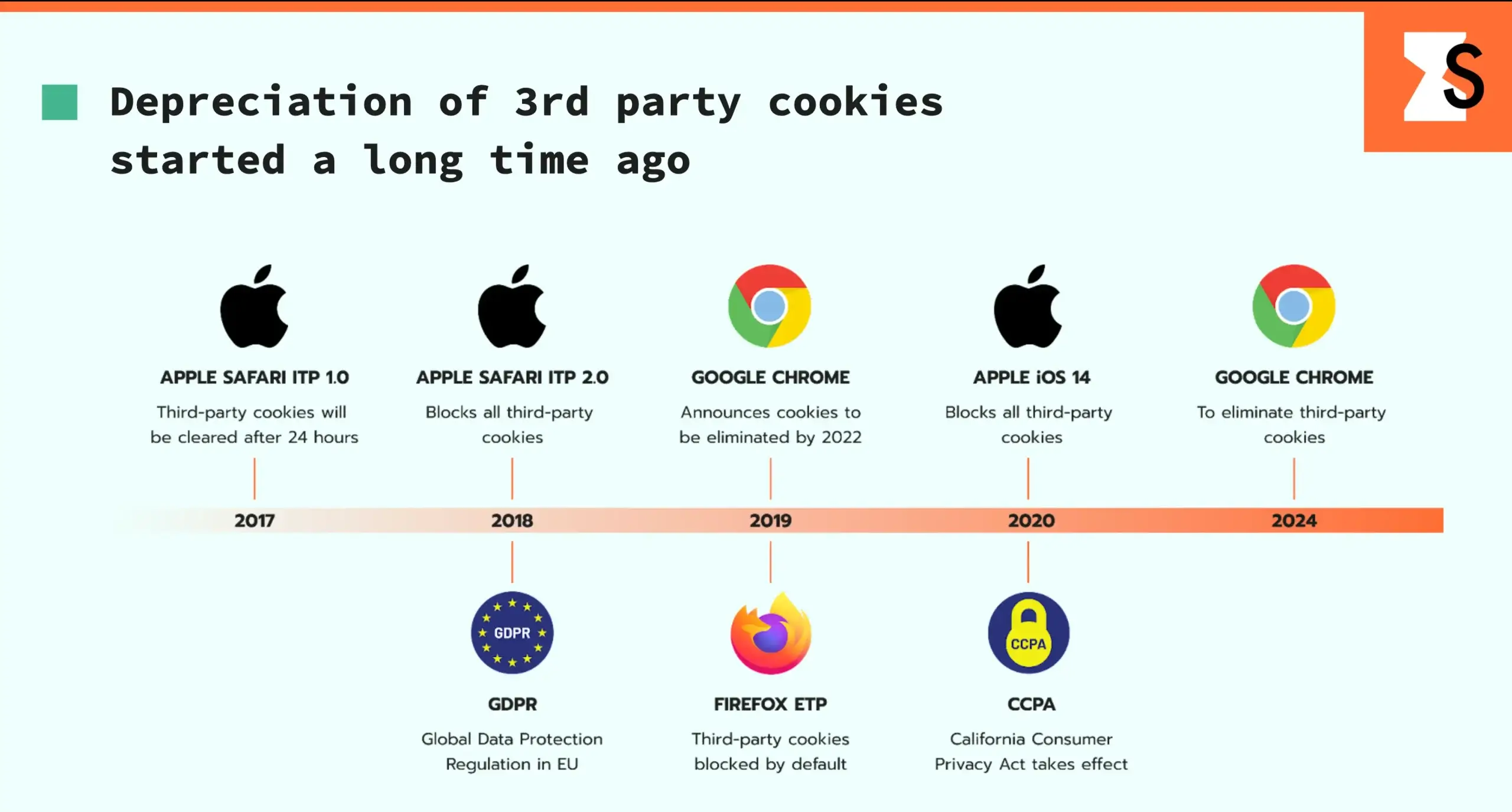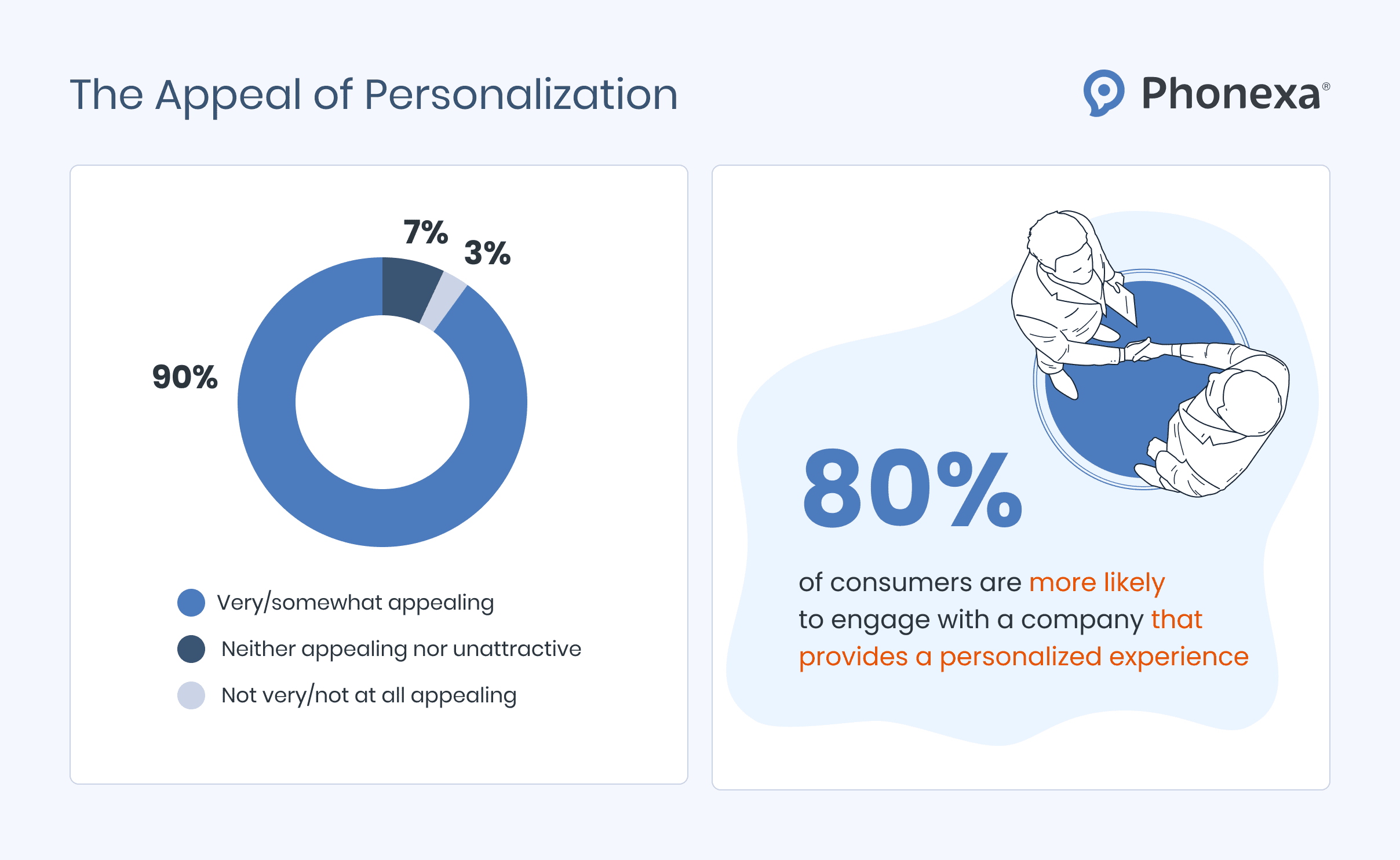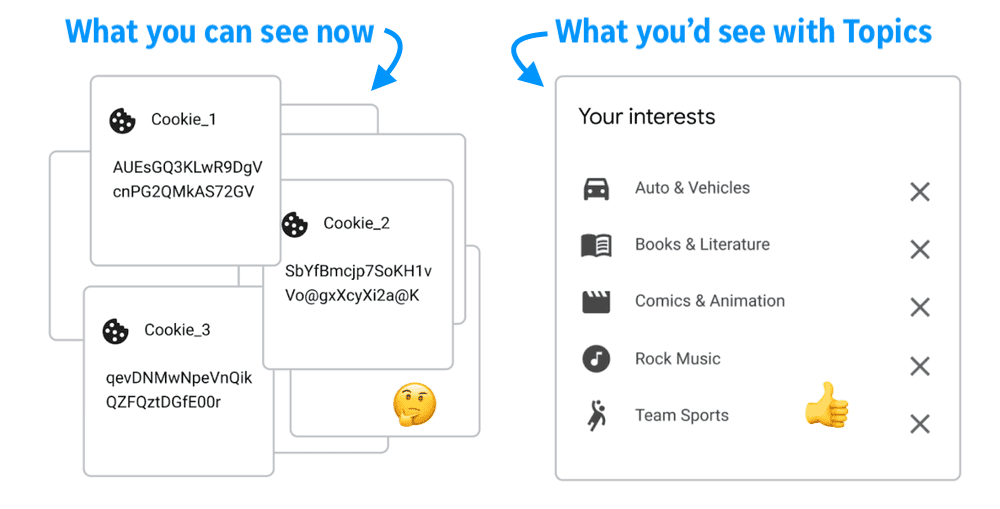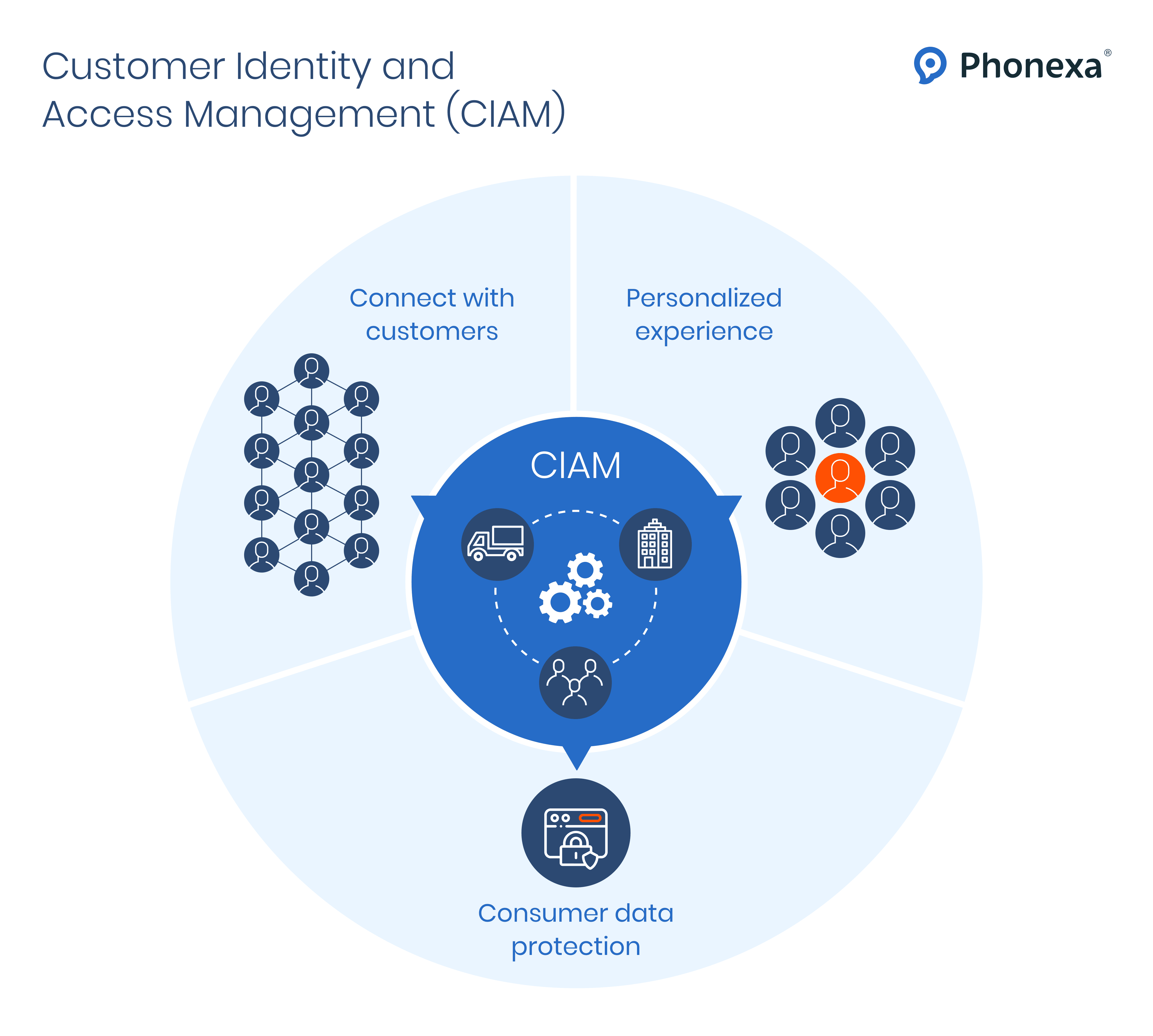
Tracking cookies has long been crucial for understanding user behavior, but their demise signals a need for innovation: cookieless affiliate tracking, a concept that appeared in 2017 with Apple’s Safari Intelligent Tracking Prevention (ITP).
The events that shaped cookieless tracking included Firefox’s Enhanced Tracking Protection (ETP) in 2018 and Microsoft’s Edge Tracking Prevention in 2019. However, Google’s decision to eliminate third-party cookies in Chrome by 2024 marked a critical turning point.
Let’s face it: cookie days are numbered.
This change is driven by stringent data privacy laws like the GDPR and California’s CCPA, which require user consent for personal data collection. While these regulations don’t specifically target cookies, they touch various tracking methods, prompting Google to introduce its Privacy Sandbox — a less precise but legally safer alternative.
The good news is that affiliates can continue to thrive by adopting new strategies.
Read on to learn everything you should know about cookieless affiliate marketing.
The Importance of Cookies in Affiliate Marketing
You might be wondering how the upcoming changes will impact you.
The short answer is that little will change. Your core operations will remain largely unaffected, whether you promote affiliate products or run an affiliate network.
However, there might be implications for personalization, targeting, and retargeting. Ad tracking cookies are a mixed bag, allowing you to identify customers while also raising privacy concerns.
Let’s revisit the significance of cookies for affiliate campaigns:
➥ Cookies are small text files stored on the user’s devices when they click an affiliate link. After the click, cookies monitor the user’s journey to the final purchase, ensuring the affiliate receives credit for the sales.
Running a bit ahead of ourselves, let’s mention that tracking without cookies is possible with the right marketing strategy and affiliate tracking software. It’s quite simple and straightforward if you have the right tools to back up your affiliate marketing campaigns.
And now, back to marketing cookies.
There are two main types of cookies: first-party and third-party.
- First-party cookies are created by websites to improve the user experience for a specific user visiting the website: browsing, shopping, etc.
- Third-party cookies are created by third parties, not the website the user visits. These cookies help track user activity and display relevant products.
Here’s a quick look at several other cookie types:
| Session cookies | Temporary cookies that expire when the browser is closed | Track user activity during a single session, helping identify the source of visits and immediate actions taken |
| Persistent cookies | Cookies that remain on the user’s device for a set period or until deleted | Track users across multiple sessions, which is crucial for attributing sales that occur days or weeks after initial interactions |
| Supercookies | Tracking cookies that are hard to delete | Enable aggressive tracking but raise significant privacy concerns |
What is a Cookie Duration in Affiliate Marketing?
Cookie days refer to how long a cookie remains active after a user clicks on an affiliate link. Think of it as a ticking clock that counts down the time you have to earn commissions. Typical durations are usually 30 to 90 days.
Longer cookie durations give affiliates a bigger window to earn commissions on purchases, whereas shorter durations can feel like a race against the clock, limiting your marketing potential. For affiliate marketers, the longer the cookie duration, the better.
Why Tracking Cookies Are So Beneficial for Affiliate Marketers
| Accurate Attribution | Cookies track user activity from the initial click to the final purchase, ensuring affiliates are credited for their referrals. Now, though, marketers are likely to be forced to use alternative cookieless solutions. |
| Improved User Experience | Cookies significantly enhance user experience by remembering preferences and login information. They allow users to avoid re-entering their details each time they visit a site, which creates a smoother browsing experience. At the end of the day, better UX results in more purchases and higher commissions. |
| Deeper Personalization | Cookies help tailor content and offer to a specific user, increasing engagement and conversion rates. |
With Google testing changes to tracking protection in the Chrome browser — offering options to disable third-party cookies and restrict data sharing for personalized advertising — it’s noteworthy that only one in ten adults in the United States typically refuse cookies on their devices, according to a Statista survey.
But then again, while blocking third-party cookies poses challenges for tracking user journeys, it also opens the door to innovative marketing strategies.
Cookieless Tracking: The Impending Phase-Out of Third-Party Cookies
Introduced in the 1990s to track user interactions, cookies have become a source of privacy concerns. By 2022, most major browsers began limiting third-party cookies, with Google Chrome committing to phase them out by the end of 2024.

Source: Stape
Improving web privacy is an ongoing effort, so Chrome continually invests in features to protect your data and provide more control over its use, including limiting cross-site tracking. The developers already tested Tracking Protection with 1% of Chrome users globally, a step towards phasing out third-party cookies by the second half of 2024, pending approval from the UK’s Competition and Markets Authority.

Source: Google Blog
As user privacy takes center stage, the phase-out of third-party cookies is upon us. Advertisers demand greater transparency about ad spending and express concerns over ad fraud, prompting Google to promote a privacy-friendly browsing experience. Firefox and Safari echo this trend by restricting third-party cookies.
The Cookieless Future of Affiliate Marketing: What’s Changing?
Third-party cookies are not illegal, but using them to collect personal data without consent is. This widespread use has led to uncontrolled data sharing, which poses risks like identity theft and financial fraud.
Here are some alternative cookieless marketing solutions:
- Leverage first-party data to enhance audience connections
- Utilize server-side tracking for improved security
- Implement contextual targeting and much more
The European Court of Justice has cracked down on unregulated third-party cookies, highlighting the critical need for user consent. Although the GDPR mandates consent for tracking, the quick agreement from many users raises questions about informed consent’s effectiveness.
Meanwhile, as Apple and Google tighten restrictions on traditional tracking, innovative solutions are emerging to navigate these challenges.
Cookieless Affiliate Tracking: Opportunities and Challenges
A significant challenge is the loss of detailed data that affiliates typically depend on for campaign optimization and audience targeting. Without this information, tracking user journeys and accurately measuring conversion rates becomes more difficult.
In practice, this means affiliates have to rely more on first-party data, encouraging users to opt in through transparent practices and valuable incentives. Likewise, attribution models must evolve beyond last-click attribution to account for multi-touch interactions in the customer journey.
The cookie ban will drive a shift in marketing strategies like creating personalized content without relying on cookies. This could include leveraging email marketing, social media, and influencer partnerships.
Additionally, brands may need to reevaluate their affiliate programs to emphasize transparency, ensuring both affiliates and customers are comfortable sharing their information. Building trust will be crucial in a cookieless environment.
The transition to cookieless advertising could potentially impact affiliate commissions, forcing brands to reassess commission structures and seek new ways to incentivize and reward affiliate performance.
At the same time, this shift presents the opportunity for higher-quality leads driven by authentic relationships. Affiliates who excel in producing valuable content and fostering trust may find themselves well-positioned to negotiate better commission rates.
The Benefits of Cookieless Affiliate Tracking
| Enhanced contextual targeting | Placing ads alongside relevant content enhances engagement and effectiveness without relying on cookies. |
| Human-centered advertising | Treating customers as humans rather than data points allows marketers to leverage their expertise and automation. |
| Cost savings and improved outcomes | Eliminating third-party cookies reduces costs by cutting out ineffective ad vendors. |
| Improved privacy | Blocking third-party cookies enhances consumer privacy, protecting users from unwanted data collection and tracking. |
| Reduced ad fraud | Abandoning third-party cookies reduces fraud and ineffective ad spending while improving ad effectiveness. |
| New targeting methods | New targeting methods like Google’s Topics API categorize user interests without personal data. |
Cookieless Affiliate Tracking Methods
1. First-Party Data Strategies
Building Email Lists
Building email lists for cookieless affiliate tracking allows affiliates to gather first-party data for personalized marketing. Around 90% of marketers believe personalization boosts success.

Source: The Power of Email Personalization [+ Proven Strategies]
User Account Systems
When users create an account, they share information that helps tailor marketing efforts to their preferences. For marketers, this means deeper customer understanding and the ability to communicate directly with them.
On-Site Behavior Tracking
Using tools to monitor on-site behavior gives affiliates insights into user interactions with their content, including clicks, time spent on pages, and engagement with products or services. This data helps marketers understand audience preferences without relying on third-party cookies.
2. Server-Side Tracking
Server-side tracking shifts data collection from the user’s browser to the server, allowing marketers to capture interactions with cookieless affiliate tracking. This method involves sending data directly from the user’s actions (like clicks and form submissions) to the server, which then processes and analyzes it.
Benefits:
- Enhanced data security – sensitive information is less exposed to potential breaches
- Improved accuracy – server-side tracking is less susceptible to ad-blockers and cookie restrictions
Limitations:
- Implementation complexity and higher implementation costs
- Potential challenges in real-time data collection
3. Contextual Advertising
Contextual advertising delivers ads based on a webpage’s content rather than user behavior, showing the right message in the right place at the right time. This unobtrusive approach aligns with the increasing demand for transparency and consent in advertising.
As marketers now turn to cookieless affiliate tracking, there’s a need for more effective alternatives, such as Google’s Topics API. The solution categorizes user interests based on weekly browsing data without collecting personal information.
The Topics API is a Privacy Sandbox feature that enhances user privacy while enabling browsers to share user interests for interest-based advertising (IBA).

Source: Wordstream
Users benefit from personalized cookieless ads without the risks of fingerprinting and can control or opt out of topic sharing. While the API supports publishers, it may favor larger sites, raising concerns for niche publishers. Ultimately, the effectiveness of the Topics API will depend on user and publisher participation.
4. Probabilistic Tracking
Probabilistic tracking utilizes machine learning algorithms to identify users based on patterns and behaviors instead of unique identifiers. This method analyzes signals like device information, location, and interaction history to build a probabilistic user profile.
5. Universal IDs and Identity Graphs
Tracking IDs, like those used in Google Analytics, are crucial for cookieless advertising.
➥ A Google Analytics tracking ID is a unique identifier automatically assigned to each website or app, enabling the effective collection and analysis of user behavior without relying on cookies. In Google Analytics 4 (GA4), this identifier is known as the measurement ID, structured as “G-XXXXXXX,” and helps ensure that user data is accurately sent to the right analytics container.
As cookies phase out, tracking IDs help categorize user interests based on their interactions, enabling careful cookieless targeting while prioritizing user privacy. By using tracking IDs, businesses can reach their audiences effectively and build trusting relationships.
6. Customer Identity Access Management (CIAM)
Customer Identity Access Managers (CIAMs) provide a personalized experience across multiple websites by allowing users to create a single profile for logging into various sites and applications. They simplify the login process like Google or Facebook but with greater control over personal data for enhanced personalization and marketing automation.
With CIAMs, users are consciously aware they are not anonymous during the login process.
 7. Consent Management
7. Consent Management
New privacy laws like GDPR and California’s CCPA mandate that websites must obtain user consent before collecting personal information. Thankfully, consent management platforms (CMPs) can automate this process, ensuring compliance with privacy regulations.
Best Cookieless Ads Formats for Affiliate Marketing
Ad formats that don’t rely on third-party cookies, often called zero-click or redirectless ads, are becoming essential for future-proofing your affiliate marketing business. They can be tracked using postbacks between the affiliate network, traffic source, and an affiliate tracker.
Here are some effective cookieless affiliate tracking solutions:
Pop-Up Ads
Pop-ups are a staple in affiliate marketing for their low cost and broad reach. Ideal for beginners due to affordability, they also offer stability and scalability for experienced marketers. Although they don’t gather behavioral data, pop ads can be targeted by keywords, location, and device type.
Push Traffic
Push notifications don’t require third-party or first-party cookies, but users must subscribe to receive them. This has made push traffic effective for sharing offers with a wide audience eager for the latest deals since its introduction in 2009. Revenue tracking is typically done via postback, making push notifications a native cookieless ad format, especially for mobile users.
Domain Redirect Ads
Domain redirects are another format of cookieless ads unaffected by privacy changes. Though pricier than push-and-pop traffic, they are still more affordable than options like Google search ads. The direct nature of domain redirects makes them an excellent choice for precise targeting.
Your Best Cookieless Affiliate Tracking Suite
By leveraging first-party data, server-side tracking, and contextual advertising, you can thrive with cookieless affiliate tracking. Transparency and building trust with users will be essential as we move forward, ensuring affiliate marketing remains a powerful tool for driving conversions and creating meaningful connections in a privacy-conscious world.
Embrace the future of affiliate marketing with Phonexa’s innovative eight-in-one affiliate and performance marketing software suite, empowering you to stay ahead:
Here’s your affiliate marketing software suite, starting at $100 per month:
| LMS Sync | Top-notch lead management system |
| Call Logic | Efficient call tracking and analytics platform |
| Cloud PBX | Reliable cloud phone system |
| Lynx | Advanced click tracking software |
| E-Delivery | Powerful email marketing tool |
| HitMetrix | Excellent user behavior analytics and CRO software |
| Opt-Intel | Effective email suppression list management solution |
| Books360 | Flexible accounting software with integrated invoice generation |
Build your plan to drive more leads through cookieless affiliate tracking, or book a demo to explore the products.
Frequently Asked Questions
What is tracking cookies in affiliate marketing?
Cookies are small text files stored on a user’s device that track users who click on affiliate links, ensuring affiliates receive credit for subsequent actions or purchases.
What is cookie life in affiliate marketing?
Cookie duration, or cookie lifespan, is the period a cookie remains active on a user’s device. If a purchase occurs within this timeframe, the affiliate earns a commission.
What are the privacy concerns associated with cookies?
Users may choose to block or clear cookies due to privacy concerns, which can impact tracking and potentially lead to lost commissions. Additionally, regulations like GDPR impose guidelines on cookie usage.
Does affiliate marketing work without cookies?
Yes, but it requires adaptations. While cookies have traditionally tracked user behavior and attributed sales to affiliates, stricter privacy regulations and heightened user awareness necessitate a strategic shift in marketing approaches.
How to track affiliate links without cookies?
There are several ways to track links without cookies. For example, affiliates and advertisers can track conversions by allowing server communication upon conversion.
Discover more from reviewer4you.com
Subscribe to get the latest posts to your email.







